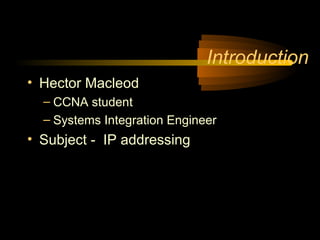
Ip address
- 1. Introduction • Hector Macleod – CCNA student – Systems Integration Engineer • Subject - IP addressing
- 2. Topics • What is an IP address ? • Types of IP addressing • Classes of IP address • Networks & subnetworks • IP addresses and routing
- 3. What is an IP address? • IP (Internet Protocol) address – device used by routers, to select best path from source to destination, across networks and internetworks – network layer address, consisting of NETWORK portion, and HOST portion – logical address,assigned in software by network administrator – part of a hierarchical ‘numbering scheme’ - unique, for reliable routing
- 4. Types of IP address • Static address • Dynamic address
- 5. Types of IP address • Static IP address – manually input by network administrator – manageable for small networks – requires careful checks to avoid duplication
- 6. Types of IP address • Dynamic IP address • examples - BOOTP, DHCP – assigned by server when host boots – derived automatically from a range of addresses – duration of ‘lease’ negotiated, then address released back to server
- 7. Class A IP address • 1st octet = network address, octets 2-4 = host address • 1st bits of 1st octet set to 0 • up to (2^24 - 2) host addresses (16.8M)
- 8. Class A IP address 124.224.224.100 01111100 11100000 11100000 01100100
- 9. Class B IP address • 1st 2 octets = network address, octets 3-4 = host address • 1st 2 bits of 1st octet set to 10 • up to (2^16 - 2) host addresses (65534)
- 10. Class B IP address 129.224.224.100 10000001 11100000 11100000 01100100
- 11. Class C IP address • 1st 3 octets = network address, octet 4 = host address • 1st 3 bits of 1st octet set to 110 • up to (2^8 - 2) host addresses (254)
- 12. Class C IP address 193.224.224.100 11000001 11100000 11100000 01100100
- 13. IP addresses and routing • routing tables • identifying source and destination • IP packet routing
- 14. IP addresses and routing -Routing tables – created by router, held in memory, constantly updated • based on cross-referencing – IP packet source address, and port on which received
- 15. IP addresses and routing Identifying source and destination – as part of a layer 3 packet, IP header contains source and destination address – each address is 32 bits long, and unique to device or port – router reads destination IP address, checks against routing tables
- 16. IP addresses and routing - IP packet routing – if destination address not on the same segment as receive port, router sends packet to correct port for routing to destination – if destination on same segment as receive port, packet not forwarded
- 17. Networks and subnets • why subnet • subnet mask • restrictions on ‘borrowed’ bits
- 18. why subnet – reduce broadcast domain, improve network efficiency
- 19. subnet masks – extend NETWORK portion, borrow from HOST portion – allow external networks to route packets direct to subnet
- 20. restrictions on borrowed bits • reserved addresses – all 0’s= network address, all 1’s broadcast address • minimum of 2 bits borrowed from host portion • minimum of 2 bits left for host portion
- 21. Phew !
